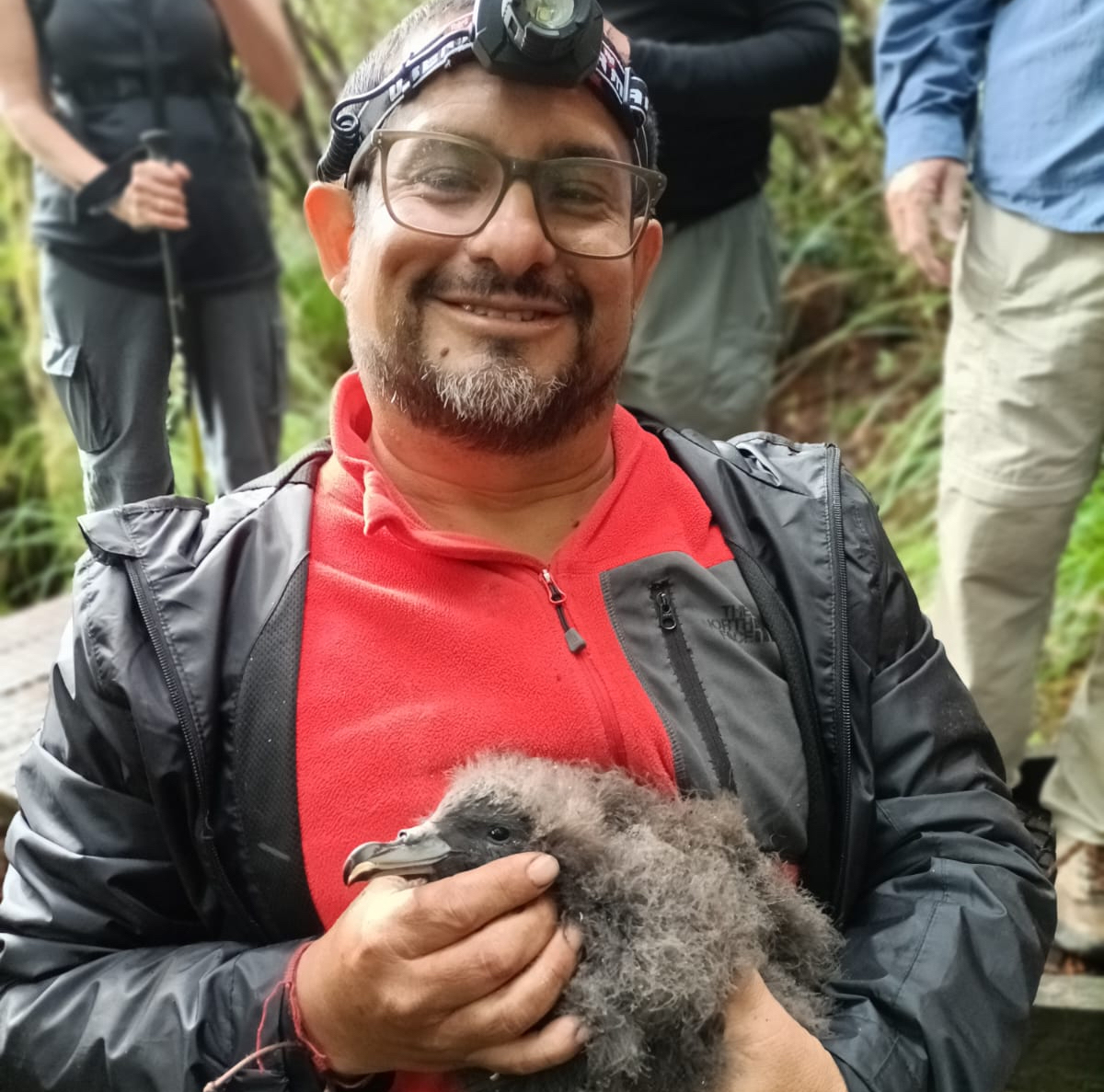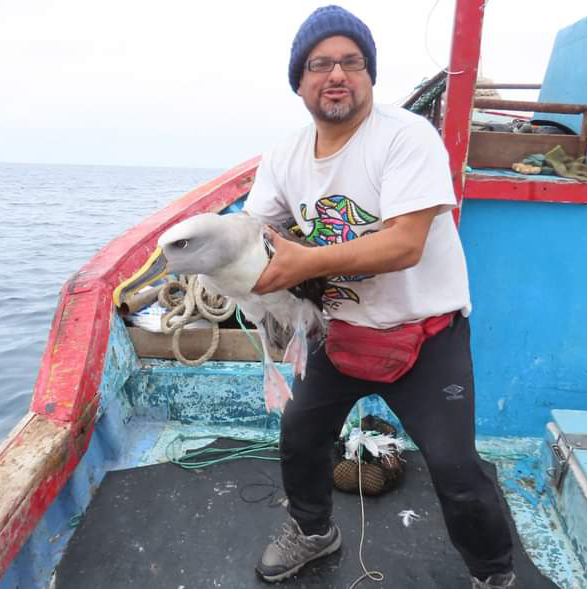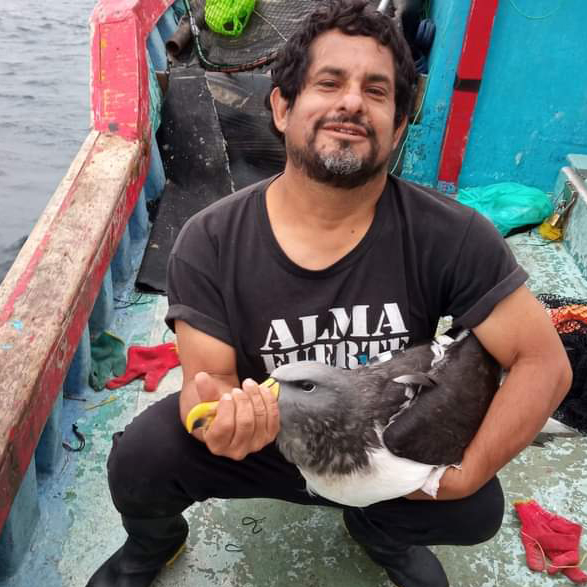 Javier Quiñones with a Black Petrel chick on New Zealand's Great Barrier Island. Javier joined NZDOC's Elizabeth Bell and her team on their project on the at-sea distribution of Black Petrels; photo courtesy of Javier and NZDOC
Javier Quiñones with a Black Petrel chick on New Zealand's Great Barrier Island. Javier joined NZDOC's Elizabeth Bell and her team on their project on the at-sea distribution of Black Petrels; photo courtesy of Javier and NZDOC
"Working on the Black Petrel (Procellaria parkinsoni) project on Great Barrier Island, with Elizabeth Bell and her team was a wonderful experience. I am deeply grateful to the Agreement on the Conservation of Albatrosses and Petrels (ACAP) and to the New Zealand Department of Conservation for this extraordinary experience." ACAP Secondee Javier Quiñones
Successful ACAP Secondment applicant, Peruvian Javier Quiñones, has commenced his Secondment with the New Zealand Department of Conservation (NZDOC). ACAP Secondments support research aligned to the Agreement’s objective to conserve listed albatrosses, petrels and shearwaters and are also required to build capacity within Parties, be international in nature, and achieve tasks within the current work programmes of the Advisory Committee (see Annex 4, MoP7 Report) and Secretariat (see Annex 2, MoP7 Report).
Javier’s Secondment focuses on addressing distribution data gaps of Chatham, Buller’s and Salvin’s Albatrosses and Black Petrels and their overlap with the artisanal fishing effort of Peruvian longline, drift gillnet and coastal gillnet fisheries. This approach allows for the identification of high risk areas, ultimately facilitating the targeted application of bycatch mitigation methods in Peru. For this end, Javier is learning about mitigation and fisheries outreach techniques in New Zealand to adapt and apply similar methodologies to the artisanal fisheries of Peru.
New Zealand’s Chatham, Salvin’s and Buller’s Albatrosses and Black Petrels are classified as some of the most endangered albatrosses and petrels by the IUCN, with accidental death from interactions with fisheries one of the most significant threats facing these four ACAP-listed species. The threat posed by New Zealand fisheries during their breeding period has been documented. However, data on non-breeding threats from fishing operations off the coast of Peru are limited.
Whilst Javier is in New Zealand, key objectives of his Secondment will be achieved through his involvement in planned activities including: meeting with bycatch mitigation experts and researchers, meeting NZDOC staff coordinating outreach to fishers, and accompanying fisher liaison officers on port visits to small inshore vessels. Javier will also engage further on joint data analyses (covering both seabird distribution data and fishing effort data) and visit seabird research projects on the North Island.
Johannes Fischer (NZDOC) stated: “I couldn’t be happier with what Javier has managed to achieve during his time here. Completing complex data wrangling exercises, banding Black Petrel chicks on the top of a mountain, and engaging with fishers on mitigation methods; he truly covered the full suite of puzzle pieces required for effective bycatch mitigation. We are very much looking forward to continuing our collaboration and reducing bycatch of our shared seabirds.”
Speaking about the experiences from his time in New Zealand and their planned application back in Peru, Javier said: “For me the project is fascinating because in the second phase, we will train the artisanal longline fishermen in southern Peru. We’ll interact with the fishing guilds to be able to apply and adapt these methodologies and minimize the bycatch of albatrosses and petrels in this Peruvian fishery, which fishing area is huge - from 80 to 400 nautical miles offshore.”
Javier, who is Head of the Top Predators Office at the Instituto del Mar del Peru (Peruvian Marine Research Institute), studied Biology at Ricardo Palma University before gaining his Master of Science in Marine Ecology Management at the Vrije Universiteit Brussels, in Belgium. He then completed his PhD at Universidad Nacional de Mar del Plata in Argentina on jellyfish occurrence and its relationship environmental variability at inter annual and inter decadal scales in the Humboldt Current System.
 |
 |
Javier in 2021 on board an artisinal longline vessel targeting sharks 150 nautical miles offshore Ilo (a port city in southern Peru). Javier is pictured (left) with a Buller's Albatross (Thalassarche bulleri), and (right) with a Chatham Albatross (Thalassarche eremita). Both species were tagged with GPS devices during the project "Integrating an onboard observer program and remote tracking data to evaluate the interactions between the small-scale longline fisheries and adult Chatham Albatrosses in their wintering grounds off Peru." which was assisted by funding from the ACAP Small Grants Programme.
After a decade of research on sea turtles and their population dynamics and foraging ecology, in 2017 he shifted his research to albatrosses and petrels, specifically their spatial distribution, seasonality, age-class distribution, foraging ecology and habitat use in Peru.
Javier has actively participated in many research cruises on pelagic seabirds along the Peruvian coast and has been involved in eleven Antarctic surveys with Peru, Argentina and the U.S.A. He has worked on surveys attaching GPS satellite transmitters on Chatham and Buller's Albatrosses in southern Peru and is currently collaborating with New Zealand’s Department of Conservation on the habitat use of Salvin’s Albatrosses and Black Petrels in Peru.
Follow Javier’s Secondment at his Instagram account, @javichojelly and find his research here.
12 May 2023

 Français
Français  English
English  Español
Español